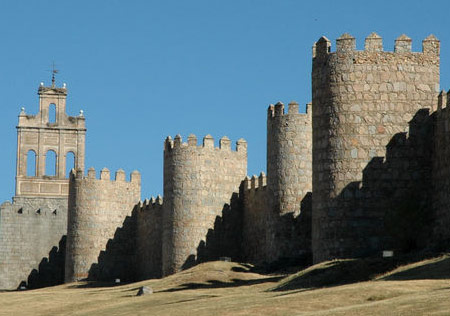History of Avila
History of Avila
Ávila, with accent on the Á is the right way of writing its name in Spanish, may have been the ancient town known as Abula, mentioned by Ptolemy in his Geographia (II 6, 60) as being located in the Iberian region of Bastetania.
Abula is mentioned as one of the first cities in Hispania that was Christianized, specifically by Saint Secundus (San Segundo). However, Avila may have been the ancient Obila instead, while Abula may have been the town of Abla.
Medieval History of Avila
Avila is most known for the medieval city walls, that were constructed of brown granite in 1090: surmounted by a breastwork, with eighty-eight towers and nine gateways, they are still in excellent repair, but a large part of the city lies beyond their perimeter.
The Gothic cathedral is integrated into the city's defences. It was built between the 12th and 14th centuries, and has the appearance of a fortress, with embattled walls and two solid towers. It contains many interesting sculptures and paintings, besides one especially fine silver pyx, the work of Juán de Arfe, dating from 1571.
The churches of San Vicente, San Pedro and San Segundo are, in their main features, Romanesque of the 12th century. In the Gothic Monastery of Santo Tomás, erected by the Catholic Queen Isabella in 1482, is especially noteworthy the marble monument, carved by the 15th-century Florentine sculptor Domenico Fancelli, over the tomb of Prince John, the only son of Ferdinand and Isabella.
Avila was fortified by the time that Castile passed into Christian control. The repopulation undertaken by Raymond of Burgundy attracted people from all areas in the Iberian Peninsula, Jews and Mozarbs (Christians who kept their religion under Islamic rule) enriched the population which came to inhabit these lands. From the beginning of the repopulation their inhabitants thought about covering their defensive and spiritual necessities, and soon the constructions of beautiful churches and the City Wall for defensive purposes, which would become the city’s symbol many years later, began.
With the unification and the Catholic Monarchs reign, Avila like all Castile, reached a prosperity stage, although it underwent serious consequences of political character, such as the expulsion of the Jewish community in 1492, of great demographic and economic importance.
This city was the witness of the birth, education, conversion and the reforming and writing work of St Teresa de Jesús. Avila, that had initiated its demographic decay with the expulsion of the Jews, held the naming of Capital of the Court of Madrid, which at that moment brought natural attraction and happiness to the city’s nobles, as well as the expulsion of the Moriscos.
During the following centuries Avila underwent a stagnation produced by the gradual reduction of its commercial interchange and the craft industry, the population decrease, the economic losses produced by the wars and the loss of the Empire, the destructions derived from the French invasion and the disappearance of the heritage caused by Mendizábal and Madoz consecutive disentailments. This situation was extended up to mid 19th century, when gradually, investments in the city increased, a railroad arrived, the Normal de Maestros and the Academia de Administración Militar were installed, being the first indications of the Avila resurgence. The city underwent an incipient industrialization and a specialization that helped to keep its uniqueness and beauty, fact that was worth being declared World Heritage by the UNESCO in 1985.
